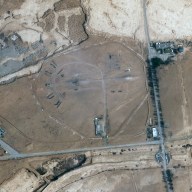 Actor Andy Serkis’ latest motion-capture role is reprising chimp Caesar in “Dawn of the Planet of the Apes.”
Actor Andy Serkis’ latest motion-capture role is reprising chimp Caesar in “Dawn of the Planet of the Apes.”
Credit: Getty Images
He’s the biggest movie star you don’t know by face (and maybe name): British actor Andy Serkis is the performer who was motion-captured to portray Gollum in the “Lord of the Rings” and “Hobbit” films, the titular super-gorilla in Peter Jackson’s “King Kong” and these days Caesar in the current “Planet of the Apes” reboot series. “Dawn,” the franchise’s latest, finds mo-cap technology at its best-so-far, which is good as Serkis will be using it extensively for his directorial debut, “The Jungle Book.” (He also has major roles in the seventh “Star Wars” picture and next year’s “Avengers” sequel.) And for the record, you’ve seen Serkis’s face before: He’s been excellent as Martin Hannett in “24 Hour Party People” and David Bowie’s assistant in “The Prestige”.
Caesar is much more reserved, closed-off, even stubborn here compared to “Rise.” How did you feel he had evolved?
Here, he bears the weight of responsibility, of leading a large group with many components. He obviously has a family now, he has a teenage son. He’s also fairly conflicted, because much as he’s an ape, he is able to talk with humans, and a part of that is very much who he is. So when the humans turn up on the scene, and there’s a possible escalation, he is the person who has to take that responsibility. He’s walking a tightrope and trying to listen to both sides and trying to find a peaceful solution. Obviously that takes a toll.
So much of this performance is in the face.
That’s right, it’s very much an internalized performance. He’s evolving to be more humanlike, because of the inherent intelligence that he grew up with. It’s coursing through his veins. We see him go from an ape who uses sign language in the beginning to using a much more philosophical and reflective use of human language towards the end.
 Here’s what the set of an mo-cap “Apes” film looks like: Jason Clarke talks to Andy Serkis as a pre-CGI chimp Caesar.
Here’s what the set of an mo-cap “Apes” film looks like: Jason Clarke talks to Andy Serkis as a pre-CGI chimp Caesar.
Credit: David James
Like the Tolkien films, the effects are done by the New Zealand company WETA. Do you work closely with themin post-production to get those subtleties of movement and facial expressions?
No. That used to be the case. For Gollum, that was the case, because when we did Gollum it was a slightly different system. My performance was filmed, as it is now, but then the animators basically copied all facial expressions afterwards. So the animators’ job was to literally match every nuance of my facial expressions. In the “Lord of the Rings” days, I used to talk to the animators afterwards, and re-enact bits for them. But today, 14 years later, the advancement of technology being what it is, the actors drive the facial capture. With the number of reference cameras on our faces, a lot of the work is done for them. Besides, our relationship spans 14 years. They’veseen every single facial muscle of mine move in every single direction, and they’ve had to read every single underlying emotion in my face.
It’s easy to feel when a milestone like this has happened that the technology has peaked. What else does mo-cap have trouble doing?
The human face is still something that has yet to be conquered. “Benjamin Button” was probably the closest thing that facial capture has got to replicating the human face. But that’s still the holy grail. And then there are other more abstract uses, and less humanoid characters, like apes or other animals. I’m about to direct “The Jungle Book,” and we will be using some performance capture technology for that. It’s the same with “Animal Farm,” another film I’ve been working on. We’ve been exploring using performance capture for creating the pigs and anthropomorphizing other animals.
Do you find your acting approach changes much if you’re doing live-action or mo-cap?
The acting process is no different whatsoever. If I was to play Gollum in a 21st century setting, and he was on the street, I wouldn’t play him any differently than if I was playing him in Middle Earth. But in terms of the back story, the emotional content of the character, the approach is the same. So for a primal ape, you have to learn physical ape behavior and movements. What this all adds up to is acting, really, and it doesn’t matter whether you’re wearing a costume or makeup, or you’re putting on a unitard and a head-mounted camera.
 The finished product: Andy Serkis is transformed into a CGI chimp that bears his facial expressions.
The finished product: Andy Serkis is transformed into a CGI chimp that bears his facial expressions.
Credit: WETA
Some of the outdoor scenes were actually filmed outdoors. What is that like, bumming around nature in mo-cap outfits?
It was great! We were just out on vacation. But from WETA’s perspective, it was a big change. They had to make sure our suits and the markers on them, which are lights that send out a pulse rather than reflect light into the camera — they had to be really robust while we’re knocking them around and scrambling over logs and jumping. Then again, we did have 100 percent humidity in New Orleans, and annoying head-mounted cameras and a ton of electronics on our backs, plus unitards. With all that you do smell worse than the worst ape, I think.
Were you a big “Planet of the Apes” fan as a kid?
My earliest memory of a film was probably watching “Dr. Dolittle.” But after that it was “Planet of the Apes.” It blew my head off, seeing apes on horseback.
Most people know your work but don’t get to see your face.
It’s liberating for an actor. It allows you to transport yourself and see yourself in any character. You are tied to a character. Because that’s what I’m here to do: I’m here to be an interesting character. If someone was to offer me a live-action role and it wasn’t as good as a performance capture role, I would take the performance capture. And vice versa.
Follow Matt Prigge on Twitter @mattprigge
















